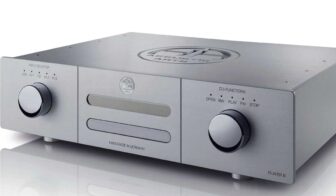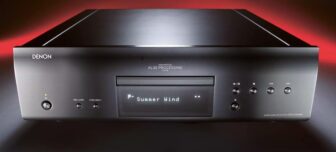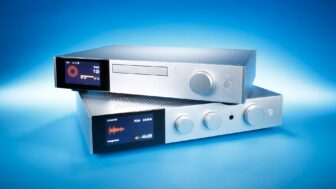TEAC VRDS-701 Review
Teac not only has great expertise with CD players but also with its own drives. But in 2023, the Japanese no longer want to rely solely on these abilities. Their VRDS-701 can also be used as a DAC and USB sound card for Mac and PC.
By Stefan Schickedanz
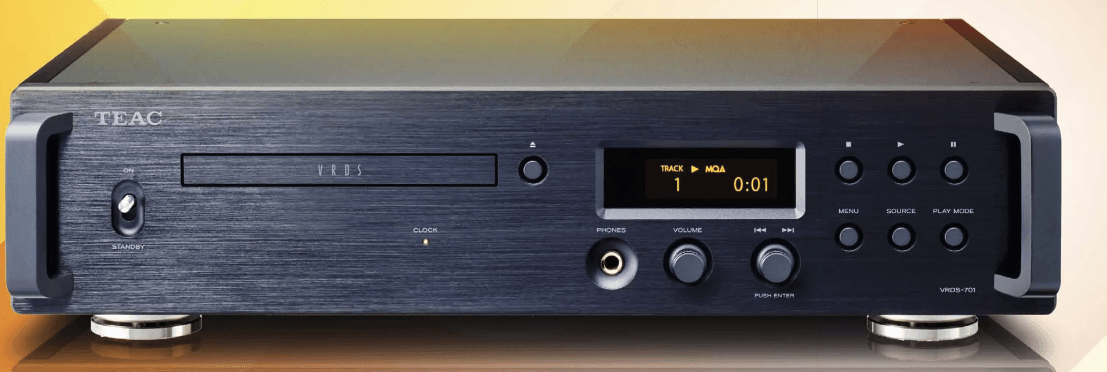
CD players are actually on the list of endangered species. Actually. But firstly, things often turn out differently than you think. Instead of disappearing from the market without a sound, the audio components once traded as successors to the apparently immortal vinyl record are mutating into multifunctional entertainers. In the past, it was not even taken for granted to be able to play a self-burned silver disc on your new CD player. The current devices now fulfill a whole handful of useful tasks.
The Teac VRDS-701 cannot and does not want to escape this trend. For $, you also acquire a veritable hi-res DAC with it. And as a bonus, there’s a portion of studio feeling as the cherry on top. Those who live the hobby of hi-fi in all its facets and not just want to listen to music can synchronize all their digital components, provided they also have a compatible 10 MHz clock input, with a central master clock.
With this high investment and the truly understandable studio background with various digital mixing consoles, effect devices, and DACs in mind, differences can be perceived. Teac even promises that the sound of the individual VRDS-701 also benefits from it. This is interesting insofar as, with the insanely high clock frequencies of today’s digital audio components, the precision of the master clock is by no means the sole deciding factor, but apart from the necessary interface, especially the length of the path over which this high-frequency signal must be transmitted. Therefore, developers place it as close as possible to the converter chip or even use internal clocks. To make it short: The author of these lines would rather invest the $ that Teac asks for the appropriate CG-10M-A master clock generator in better speakers or amplifiers. But as is well known, trying is better than studying.
In any case, a solid CD drive proves to be undeniably useful. In this area, Teac has earned an excellent reputation in both hi-fi and computer applications. The VRDS-701 even owes its name to the “Vibration-Free Rigid Disc-Clamping System” (VRDS) designed by Teac itself.
Again, a certain studio background resonates here.
The manufacturer proudly points out that this mechanism has long proven itself in broadcasting. Audiophiles are already familiar with the idea behind it from various other CD drives in high-end players. The silver disc is fixed by a platter of identical diameter. This is intended to prevent vibrations and stabilize rotation, thereby minimizing the currents for the servo control of the laser pickup. After all, the interference spikes of the servos can break through as HF radiation into the sensitive audio circuits. However, uneven CDs are rather rare, and the question arises as to what extent the greater mass of the VRDS platter increases the currents in the servo control due to its much stronger drive motor. In any case, it’s good to know that Teac took care of all the details in the drive and did not skimp on effort.
UNWANTED VIBRATIONS
Unlike the heavy platter compared to the usual CD spindle, the Japanese relied on very light yet stiff plastic resin for the bearing of the drive, which is intended to prevent the transmission of vibrations to the chassis and vice versa. Another step in the same direction is the semi-floating mounting of the entire pickup unit. But it’s not only such mechanical measures that might make audiophiles want to buy a CD player for eternity again. If there’s something that sends well-heeled high-enders into rapture like gourmets savoring Kobe beef, it’s known to be official power supplies with toroidal transformers. This is especially true when these low-leakage voltage converters appear in pairs.
That’s exactly the case with the VRDS-701. The separation of the two stereo channels begins at the power supply and continues through the digital-to-analog conversion section to the analog output stage. The consistent dual-mono design ensures minimal crosstalk for a stable image. But those who think the circuit design of a digital audio device to its logical conclusion are unlikely to be satisfied with just separating the channels. There was something about interferences in sections where lots of HF disturbances occur. Therefore, the digital control unit and the CD drive also got their own toroidal transformer.
DO-IT-YOURSELF DAC
That Teac takes sound quality seriously is also particularly impressively expressed in the D/A converter itself. Here, the developers did not simply use the usual off-the-shelf products from manufacturers like ESS, Texas Instruments, or Asahi Kasei. Instead, they rely on a custom solution using an FPGA chip with a maximum resolution of 32-bit/384 kHz. The abbreviation stands for Field Programmable Gate Array, which means that ambitious users like Teac or Chord Electronics can freely program these chips to use their own algorithms.
The Japanese perform D/A conversion according to the sigma-delta principle, which became popularly known as 1-bit conversion. This allows them to directly convert DSD bitstreams up to 22.5 MHz into analog sounds without prior format conversion into PCM signals. This makes sense insofar as it reliably prevents jitter problems during clock conversion as well as potential data rounding errors right from the start. However, the DSD data at Teac does not come from a rotating disc. While the drive plays redbook-compliant audio CDs, CD-Rs, CD-RWs, or MQA CDs, it does not play SACDs.
However, DSD is not left out. After all, the VRDS-701 has a USB-C connection, allowing it to be used as an external sound card for a PC or Mac. In doing so, the Teac can use not only asynchronous transmission but also Bulk Pet USB—a method that perfectly balances the data transfer between computer and playback device for optimal sound.
To be able to use this mode, even Macs exceptionally require a driver provided by Teac.
ATTENTION TO EVERY DETAIL
In addition to such digital refinements, there is also solid basic work on the analog outputs. For the headphone output, Teac focused on low noise, fast response to impulses, and high current delivery capability. With the variable amplification Teac-QVCS (Quad Volume Control System) with 4-way volume control, the VRDS-701 is also very suitable for direct use with a power amplifier and, of course, quite modernly, for controlling active speakers.
One could use many words about the countless, elaborate, and lovingly designed details of this multifunctional CD player, such as the three multi-part absorber feet, but there is also much to report sonically. In the listening test on the reference system, the Teac was convincing both with compact discs and with high-resolution audio files from a computer connected via USB. Fundamentally, the extremely stable spatial imaging with a three-dimensional stage and very sharply focused solo instruments and vocalists stood out. In the bass, the VRDS-701 sounded nicely full, but at the same time also somewhat less punchy than when converting the sounds via the Musical Fidelity M3x DAC, which is also tested in this issue.
With hi-res audio, the Teac was able to gain once again in resolution and transparency. The differences between the switchable digital filters could then also be grasped somewhat better. However, it’s about nuances, and it’s hard to make a clear preference despite small differences, especially in the overtone range. After all, with this nicely implemented gadget—when switching, the sound fades out and in smoothly—you can actively listen and discuss the result with friends.
Just like back then, when Apple computers were still in the graphic departments of editorial offices or advertising agencies, and the CD was the measure of all things in consumer electronics.
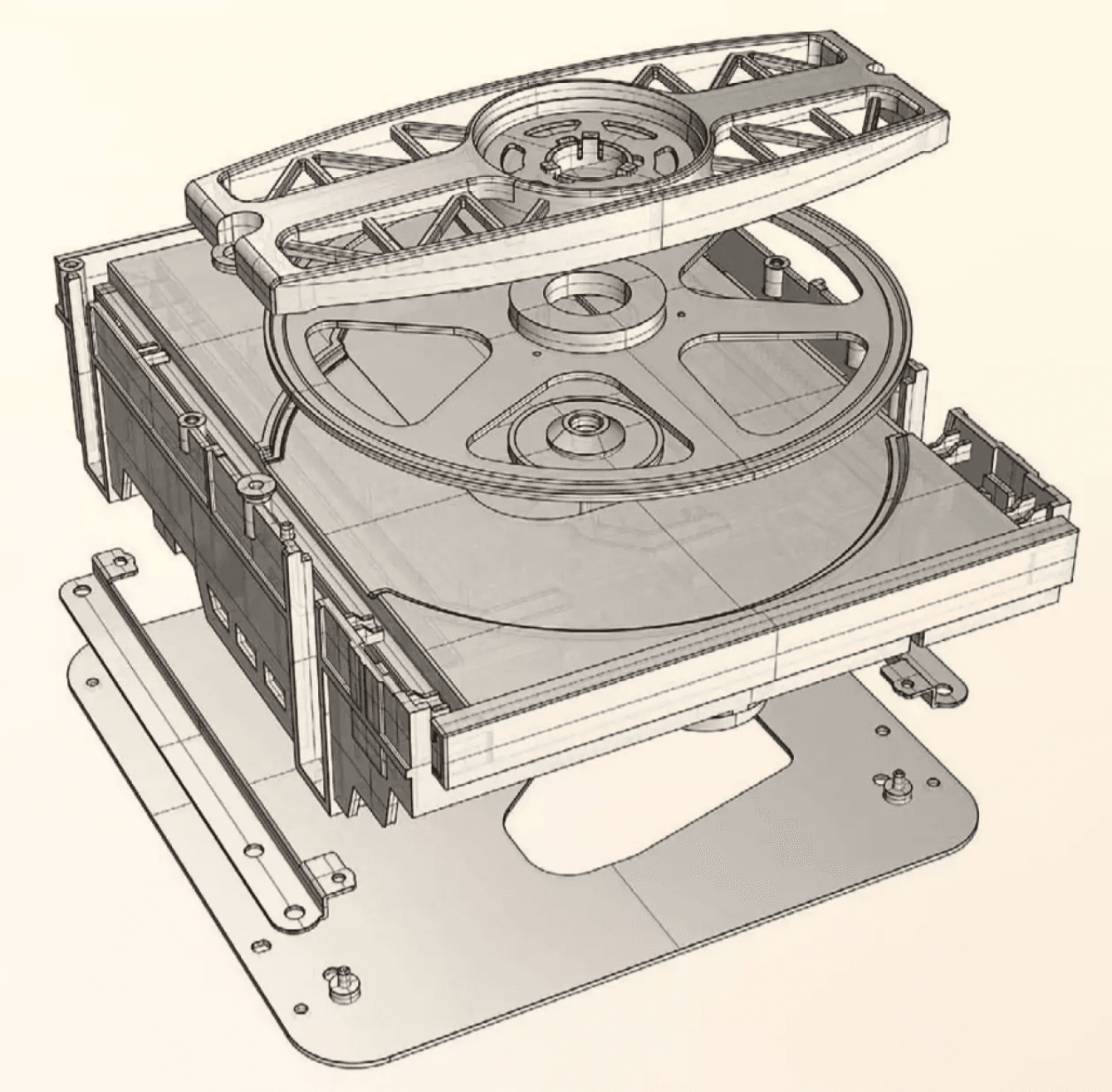
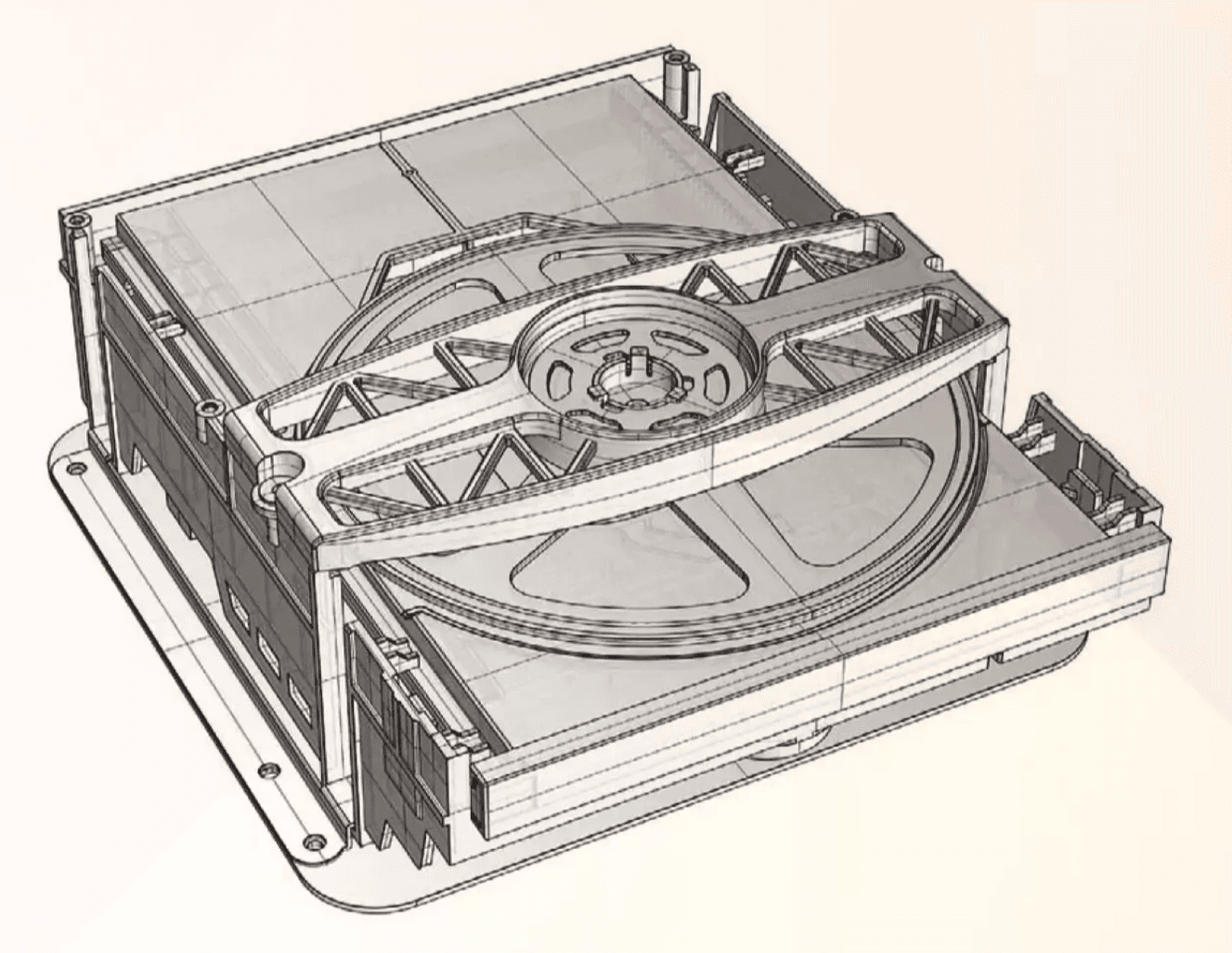

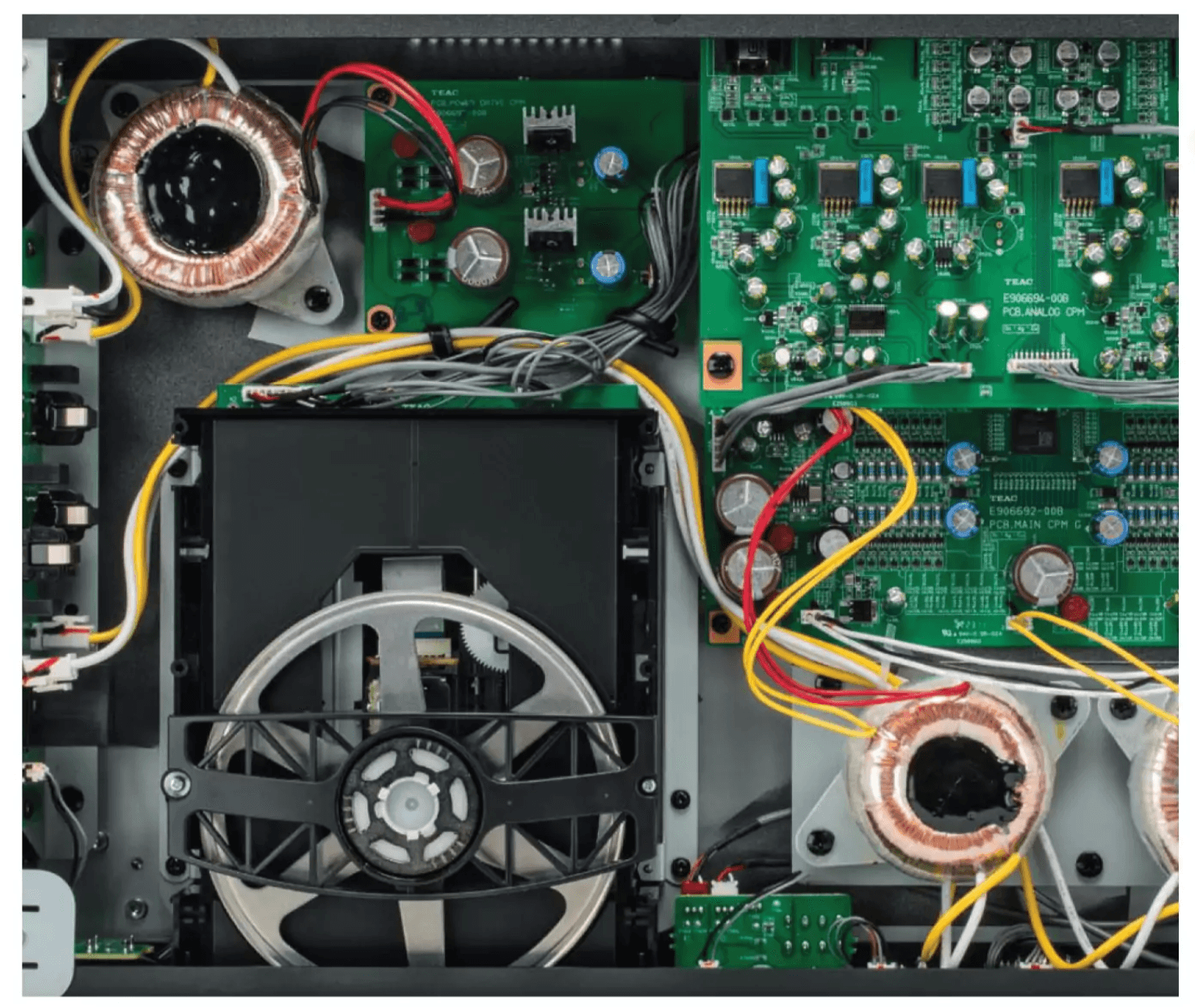
MEASUREMENT LAB
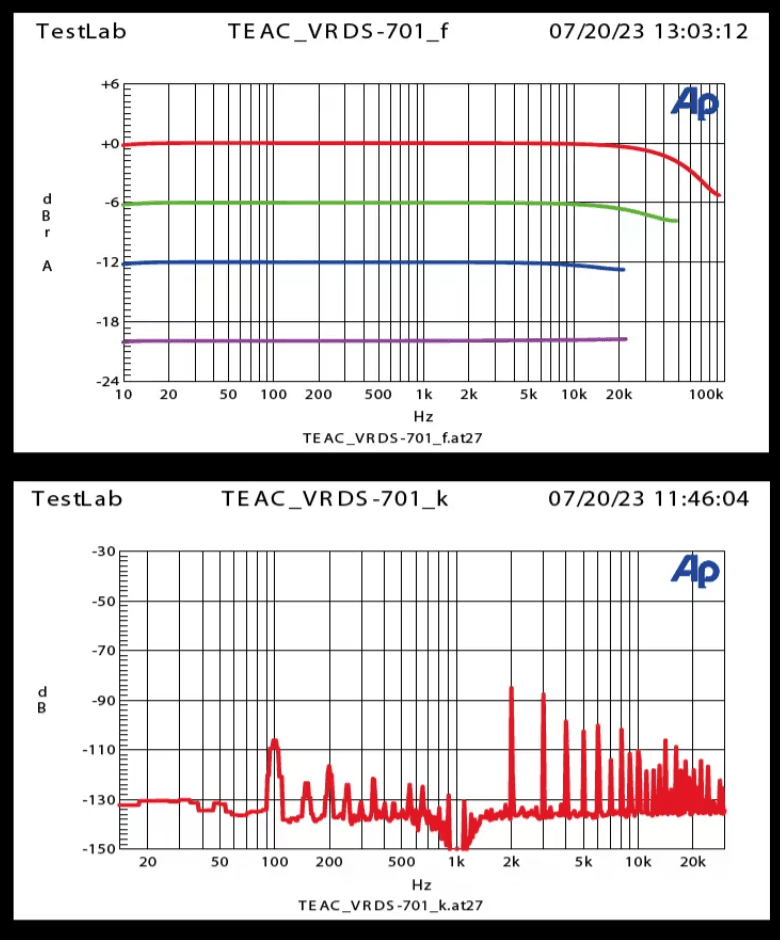
Frequency responses: Perfectly linear playback curves in DAC mode (measured at PCM 192, 96, and 44.1 kHz) as in playback of pre-emphasis coded CDs (magenta). Distortion spectrum, 1 kHz with 0 dBFS: low noise floor, minimal 100 Hz hum residue; higher-order distortion harmonics are only present at very low intensity, total harmonic distortion plus noise THD+N 0.01%. Delivers clean, finely gradated, and widely adjustable signal in volume at the line outputs as well as at the headphone output: displayed control range −95 to +24 dB; output voltage (nominal/max) 1.9/5.7 V (RCA) or 1.9/11.5 V (XLR); output impedance 63/230 Ω (RCA/XLR); SNR DAC 109/107 dB (RCA/XLR, A-weighted, 1.9 V); SNR CD 99/97 dB (RCA/XLR, Digital Zero/with residual signal). Powerful, universally usable headphone amplifier: output impedance 13 Ω; voltage at 32 Ω 4.0 V (500 mW), at 300 Ω 5.4 V (97 mW). Power consumption standby 0.1 W; operation 14/16 W (DAC/CD).
Specifications:
- Distributor: Aquipa
- Website: teac-audio.com
- Warranty: 2 years
- Dimensions (W x H x D): 44.4 x 11.1 x 33.4 cm
- Weight: 11.8 kg
Features:
- Random Track Selection: Yes
- Play Time Display (Track/CD/Program): Track and CD
- Remaining Time Display (Track/CD/Program): Track and CD
- Repeat (CD/Track/A–B): CD and Track
- Remote Control: Yes
- Output (Variable/Fixed): Both available
- Output (Cinch/XLR): Both available
- Digital Output (Cinch/Optical): Both available
- Headphone Output (Adjustable): Yes
- Digital Input (Cinch/Optical/USB): All available
- USB-Host/iPod: Not available
- Special Features: Connection for external clock
Audiogram (Review Summary):
Pros:
- CD player and Hi-Res sound card in one, excellently implemented
Cons:
- No SACD playback, even though the D/A converter supports DSD
Sound (Cinch/XLR): 115/115
Evaluation:
- Features: Very Good → 9/10
- Usability: Very Good → 9/10
- Build Quality: Very Good → 9/10
Final Score:
- Sound Rating: 115 points → 9.2/10
- Price/Performance: Very Good

CONCLUSION
CD players have evolved. In order to compete in the race of formats, they had to become more versatile. Why should one still buy a pure disc spinner today and end up putting a technology tower in the room? After all, we’ve gotten used to being able to listen to music quite properly with tiny one-box systems thanks to technological progress. The Teac also uses its elaborate converter technology for hi-res files via USB. That absolutely makes sense, especially since it sounds really good.
When you purchase through links on our site, I may earn an affiliate commission. Here’s how it works.
The TEAC VRDS-701 is the END GAME CD PLAYER!
In this video, I'll reveal why the TEAC VRDS-701 is the END GAME CD player and why you need it in your life. Buy the TEAC ...








